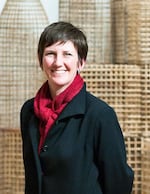
Krajewski's currently working as director of the Institute of Visual Arts (Inova); University of Wisconsin-Milwaukee.
Courtesy of Portland Art Museum
Portland Art Museum has just announced the hiring of Sara Krajewski as the museum's next curator of modern and contemporary art. The last person to hold the job was
Bruce Guenther who left in October 2014
.
Krajewski comes from the Institute for Visual Arts at the University of Wisconsin-Milwaukee. Before that she curated Seattle's Henry Art Gallery.
We talked with Krajewski about her experience and her hopes for the new job.
Q&A with curator Sara Krajewski
April Baer: PAM's Executive Director Brian Ferriso worked in Milwaukee Art Museum at the same time you were curator of exhibitions at the Madison Museum of Contemporary Art. Did you two know each other?
Sara Krajewski : Yeah, I had the opportunity to meet with him. They were looking for a curator of modern and contemporary art when he was head of the curatorial team there. I came over and had a nice conversation with him. That was nearly 20 years ago.
Baer: What appealed to you about this opportunity?
Krajewski: I saw it as a really interesting platform for my work. I've been working at INOVA for the last three years, it's a university art gallery, focused on contemporary art exhibitions. I've been interested in going back to the museum world, to work with a collection, to work with a team of curators.
Baer: What are you most proud of in your prior jobs?
Krajewski: Well at INOVA, I'm most proud of the ambitious programming we were able to do connecting the art exhibitions to the broader campus community, particularly an exhibition of artists' responses to environmental change. I really felt strongly art should be a part of these interdisciplinary research conversations.
Baer: What did you and the hiring committee discuss about the mandate for this position?
Krajewski: Talking with all the staff I met through the interview process, there's a real desire for collaboration across the curatorial department. I'm particularly interested in collaborating with the education team. There's dynamic work going on. I also heard there's a real interest in foregrounding contemporary art acquisitions, and bringing more cutting and recent art into the collection.
Baer: There's some overlap with Northwest art. How might you handle that?
Krajewski: I think there will be quite a lot of overlap among all the departments, contemporary Native American art, prints and drawings, the Northwest collection, photography is a very important part of contemporary practice some really interesting opportunities that ill present themselves in ways to support and cross-fertilize aspects of the collection.
Baer: What do you know about the resources you'll be working with to acquire works for the collection, and how do you hope to work with area galleries?
Krajewski: I think the museum does present a platform for educating and supporting the galleries activities and in educating the public in how to go about collecting. I'm interested in getting to know the Contemporary Art Council at the museum, finding ways they can support acquisitions. Many museums face this challenge as the art market explodes and prices explode. You need to be creative and resourceful in the way you pursue acquisitions.
Baer: One of the Museum's biggest gets to date was also one of its more controversial: The exhibition of Francis Bacon's triptych, "The Studies of Lucian Freud." Some artist and collectors saw that as a fast and loose approach to getting work on display. Is working with out-of-state collectors something you feel comfortable doing?
Krajewski: Yeah, I think it's important to make sure there's a very solid relationship being built with out of state collectors, so the museum benefits over time, and so that these situation don't present themselves as one-offs. It's important to make sure we're on solid footing, and there's potentially a longer-term commitment.
Baer: Any ideas you can share about shows you'd like to see at PAM?
Krajewski: I don't want to name too many names without having vetted some things with staff and Brian (Ferriso), but one thing that really excites me is the video space that was created for the Richard Mosse exhibition. That presents a lot of opportunities to expanding video installations, possible also for collecting that type of work. My own research lately has been into interdisciplinary art that includes performance. We might want to explore some of that. One of my final projects here will be a durational dance installation with a Minneapolis-based choreographer, Morgan Thorson.
I guess I've always been interested on getting to know the context in which I'm working. Getting to know the collection, the community, will start to shape choices I might make for larger projects I bring to the table.
Some of the work I did at the Henry and continued here at INOVA was working with artists to realize new work. Commissioning or facilitating the production of new work is something I hope to continue do to.
